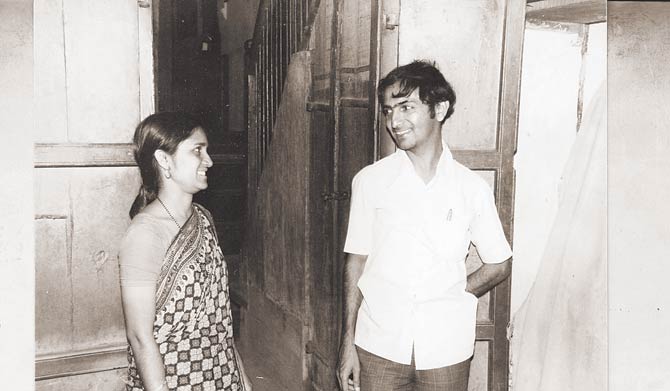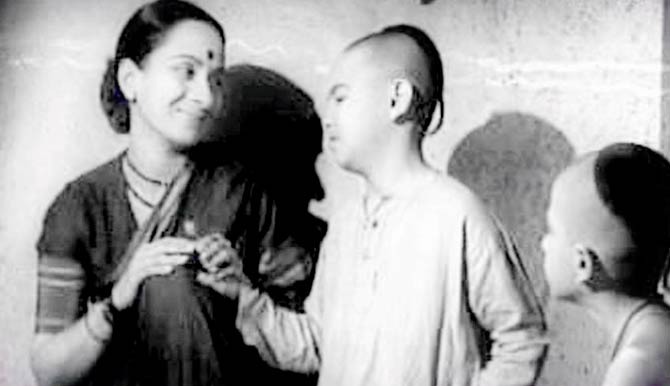Shyamchi Aai’s child artiste Madhav Vaze, now a 75-year-old theatre director-critic, allows us a peep into an upcoming memoir

 At 75, Madhav Vaze is bound by one assignment — to be honest in his recall of experiences associated with the making of the iconic 1953 Marathi film, Shyamchi Aai, where he played the protagonist Shyam. Vaze, now working on his memoir, feels an ‘if-not-now-then-when’ urgency to speak on behalf of his 12-year-old self, who became an overnight superstar in a bargain that was elevating but not entirely fair. While acknowledging the life-altering exposure the film offered, Vaze has candidly shared the small and big jolts that Shyamchi Aai gave to a shy underexposed school-going child artiste from Pune who had never faced the camera, never lived in a big city, and never dealt with mavericks like film director Pralhad Keshav Atre.
At 75, Madhav Vaze is bound by one assignment — to be honest in his recall of experiences associated with the making of the iconic 1953 Marathi film, Shyamchi Aai, where he played the protagonist Shyam. Vaze, now working on his memoir, feels an ‘if-not-now-then-when’ urgency to speak on behalf of his 12-year-old self, who became an overnight superstar in a bargain that was elevating but not entirely fair. While acknowledging the life-altering exposure the film offered, Vaze has candidly shared the small and big jolts that Shyamchi Aai gave to a shy underexposed school-going child artiste from Pune who had never faced the camera, never lived in a big city, and never dealt with mavericks like film director Pralhad Keshav Atre.

Madhav Vaze with wife Shailaja at Karve Road in Pune. Pic/Manda Tannu
ADVERTISEMENT
In his words, “I was a Puneri karata brought up on toop (ghee), metkoot (a powdered mixture of lentils and spices) and bhat (rice) served with the attention and love of a well-to-do joint family. My father (a teacher at the Nutan Marathi Vidyalaya, Appa Balwant Chowk) was unimaginably proud to lend his son for a film based on Sane Guruji’s moral precepts; he did not even think of the honorarium; just happy that I was allowed to attend school intermittently and that I was not put up in a hotel but in Acharya Atre’s home at Shivaji Park.” It is another story that life was far from idyllic at the Atre residence, where a bedroom gallery became little Madhav’s rest stop, with practically no one to talk to.

A photograph of a younger Madhav and Shailaja
Vaze’s is not a recollection of harshness inflicted by Atre or actress Vanmala (who played the mother), but it is a true-to-life representation of some revered figures of Maharashtra. “Both Saheb [he called Atre by that name] and Vanmalabai have passed away. I have digested the past and risen above the unpleasantness of my situation. So, I can capture ‘Shyam’s mood’ objectively, without mincing words. These revelations are as much a part of the film as is its celebrated onscreen depiction of a child coming to terms with life.”

A still from Shyamchi Aai in which actress Vanmala played mother to Madhav Vaze’s character
Vaze’s observations are amusing because Shyamchi Aai is a veneration of a mother’s positive upbringing which instills the best of human values to survive the worst of adversities. It required a performer to render a poverty-stricken precocious kid belonging to a debt-ridden Konkan household where the father falls on bad days while the mother battles on courageously. The child artiste essaying the lead role needed emotional warmth to overcome his homesickness. While it was his “extreme good luck” to be chosen as Shyam at an age where he did not fully realise what had come his way, he sulked and wished for friendlier company. “Atre was a busy person with little time and inclination for a chat. Making a movie was one part of his social life. His flat was abuzz with interesting people of various callings. They enjoyed drinks, ate fish and purred politics. I was the outsider — uncomfortable, unused to westernised ways. I had not lived in a house with a dining table, a refrigerator and a commode.”
Had there been some offline mother-son chemistry between the real-life Shyam and actress Vanmala, it could have compensated for Atre's indifference. “But she was my mother only on screen and I wanted more, someone to hold me tight before I slept.”
“The only time when she really cared for me was when the unit went to Delhi for the President’s award. We were invited to the award party night, but she left the scene along with me. She felt it was not meant for a child.”
Vaze gives credit to the co-producer, Dattatray Sathe, who sensed the young Madhav’s suffocation and invited him to mingle with his four children at the Gangaram Khatri Wadi in Girgaum. “As I played cricket with the four siblings and saw some papad-lonache on my plate, I felt normal. I told Sathe (Nana) that I will stay with them.” With the Jyoti Studio (Kennedy Bridge) just a few tram stations away, life seemed sorted out — a budding Mumbaikar had begun to commute on his own.
The memoir honours Shyam’s popularity, which has lasted Vaze a lifetime; unknown people have showered him with love because he was ‘their’ Shyam. The fan club transcends geographical boundaries — embracing Maharashtrians settled in the US, UK and Europe; students of other nationalities studying in Pune; film and theatre buffs who are familiar with Vaze’s writings and spread all over the world. Most notable is the instance (1983) at the Indian High Commission office in London where a Gujarati gentleman (official) convinced the French Embassy to grant Vaze a visa, stating, “You have made us cry at one point. What can I do for you? If the French don’t give you a visa, I will ban their entry into India.” Shyamchi Aai had come to Vaze’s rescue in an alien land, 30 years after its release. “Saras Baug to San Francisco, supermarkets to airport lounges, bank counters to critics’ symposiums, Shyam follows me like a mobile network.”
Vaze prides himself on his post-Shyamchi Aai achievements — as an English professor, a promoter of 300-odd children’s plays (Nandanvan the most notable), the founder of the Jagar theatre group, the director of plays like Tughlak, Oedipus and Hamlet (as late as 2014), the writer of Rangmudra (14 theatre veterans’ interviews) and a vocal member of the International Association of Theatre Critics, representing India in several fests including Festival d’Avignon and Sterijino Pozorje.
Despite the phenomenal adulation, Vaze has not failed in his objective analysis of the factors that triggered Shyam’s success. Much before the memoir took shape, Vaze has been candid in stating that Shyamchi Aai is a heavily sentimental movie, which Atre intentionally (and successfully) premised on the sure-shot saleable theme of the mother-son bond. “His gamble just worked, naturally because of the outstanding empathy that the actors could evoke.” Vaze has a bagful of anecdotes that relate to the period when the movie did not do well after its release. Atre ‘engineered’ several felicitation ceremonies for Shyam in order to evoke public interest.
Shyamchi Aai is a construct that stands for the well-behaved, conscientious, gentle child brought up on nationalist ideals of a newly Independent India.
He is a product of a religious joint family steeped in ideals that were true to its times.
While going about his daily business of life, Vaze is often told by parents that they want to inculcate a Shyam-like moral code in their children. He wonders what that means in today’s context.
Sumedha Raikar-Mhatre is a culture columnist in search of the sub-text
 Subscribe today by clicking the link and stay updated with the latest news!" Click here!
Subscribe today by clicking the link and stay updated with the latest news!" Click here!







